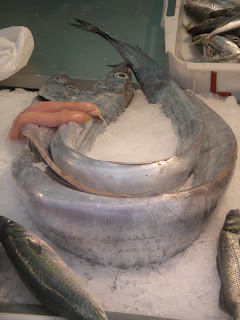On
Monday, May 28 (our one month anniversary!), we left our cozy Lisbon flat and
hopped the 10:30 p.m. train to Valencia de Alcántara where we would be picked
up by our first farm hostess and taken to the pueblo of San Vicente de Alcántara. I gotta say, even the train's cheap seats were pretty
posh! Reclining, squishy, comfy seats, heavy
curtains to block the sun if you want to sleep, hooks for your purse above your
head – seriously, the airlines should take notes! For the next five hours, we read, dozed,
played around on our new little travel laptop, and snacked on the last package
of PigWizard lonza, dried apricots, Mary’s Gone Crackers, and the last chunk of
Charlie and Rachel’s delicious wedding gift: red wine soaked, honey and lavender
rolled, goats milk manchego. Clearly we
were roughing it!
We
washed the snack down with a water bottle half full of leftover red wine and
half full of water. Interesting choice
of beverage, you say? Well, back at the
flat, Jonathan had found that one of our metal water bottles was only half full. Knowing that I guzzle water like it is the elixir
of life (wait, it is!) and being the thoughtful husband that he, he kindly
filled the bottle the rest of the way full with water. Only when he took a sip did he realize his
folly! Ah, well, the mixture was so
nasty that it forced me to nurse the half bottle of wine for the whole 5 hour
trip!
Since
it had been a while since I had been on a European train, catching the “red-eye”,
I couldn’t remember the stop notification protocol. As we rolled to a stop at the first station,
there was no announcement; the train simply stopped for a minute or two and
then carried on down the tracks. Given
that we were seated down the aisle a ways from our bags, and it was likely that we would only have seconds
to gather up our belongings before the train took off again, as the hour drew
near to our arrival time, we were a little anxious. Every time the train slowed, we pulled the
curtains aside and tried to catch a glimpse of the station sign.
Finally,
when we saw the sign for Valencia de Alcántara, we gathered our day packs,
Kindle and laptop, grabbed our bags and jumped off the train. Seconds after deboarding, we were approached
by a dark haired English woman in her mid-forties who could be non-other than
our farm hostess. It turned out that the
reason she had directed us to get off at the Valencia de Alcántara stop rather
than the San Vicente de Alcántara stop was that the train waits in this station
for an hour and the drive to San Vicente from Valencia was only about 10
minutes. Given that there wasn’t a
chance that the train would take off any second, Jonathan thought it might be a
good idea if he double checked our seats to make sure that we hadn’t left
anything on the train. When he came back
holding the only light sweater I had brought to Europe and my new
pick-pocketing resistant purse, I had no words.
Nice work, Nicole, great start to responsible traveling.
After
triple checking that we had everything, we climbed into our hostess’s car. One whiff and my first reaction was to quietly
whisper to Jonathan, “This car smells like horse shit.” I then checked myself thinking that this city
slicker had better get used to questionable smells, etc. seeing as we were headed off to
farm life after all.
After
a short drive in the 3:00 a.m. darkness, we arrived at the finca (farm). Our hostess
opened the door and led us down a hallway with floor to ceiling windows lining
one wall and into the newly redesigned kitchen.
A cornucopia of fruit and vegetables lay in baskets on one granite counter
top, a mini meat slicer on another, and in the middle of the kitchen was a large
family style wooden table with benches on either side. This looked promising!
Our
hostess then led us through another door, down another corridor and into a
little room at the end of the hall. I
looked around at the unpainted walls, the light fixtures hanging out of the walls by their cords, and what was that smell?
Don’t get me wrong, it wasn’t a bad smell per say, it just smelled like
stuffy plastery weirdness. She showed us
the nice big closet (score!) that housed three hangers (uh, I'm gonna need a few more) and the unfinished
bathroom and shower whose curtain was held in place with linked zip ties. Ok, clearly they were remodeling or this was
just a new part of the house that hadn’t yet been finished. No big deal.
It was about 3:30 a.m. at this point, so our hostess bid us goodnight. We stood in a slightly stunned, more tired than anything silence for a minute and then
decided to check out the kitchen a little further since that seemed the most promising
aspect of the house so far. As we
re-entered the kitchen I took a second look around and noticed the television
sitting on pieces of cardboard surrounded by random junk: a broken fan, some
papers, a dirty plastic box, books, etc.
I opened a drawer and found all of the silverware, sharp knives, and serving
utensils thrown haphazardly in one heap, absolutely no organization whatsoever. Why did I get the feeling that this drawer
was a strong indication of what was to lie ahead?
We
opened a second drawer and quickly discovered the need for the mini slicer: a
whole drawer full of vacuum sealed cured and smoked meats! Ok, this couldn’t be all bad, let’s just get
some sleep and we’ll see what happens tomorrow.






























